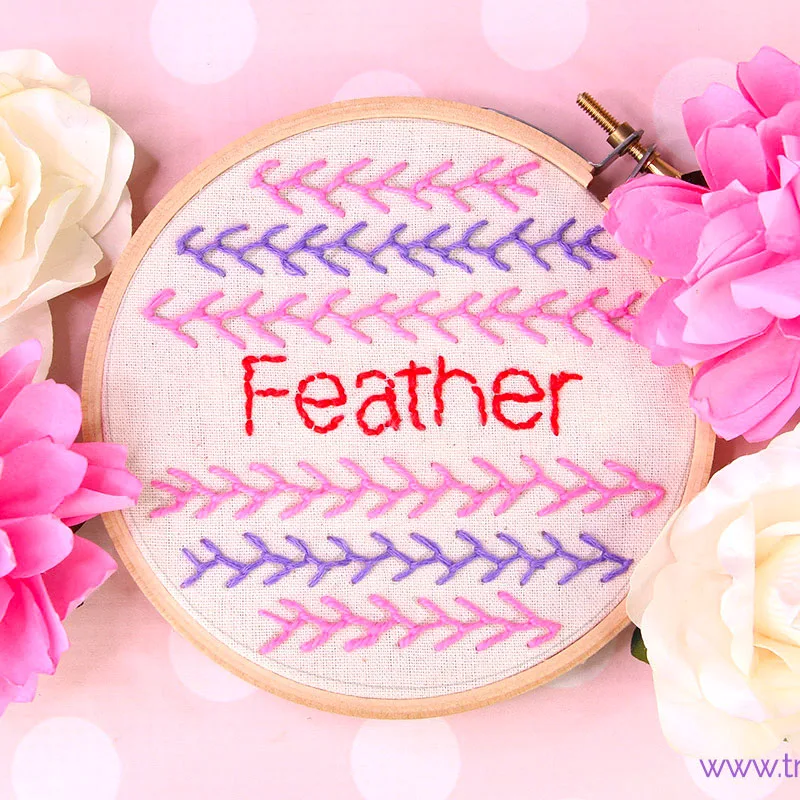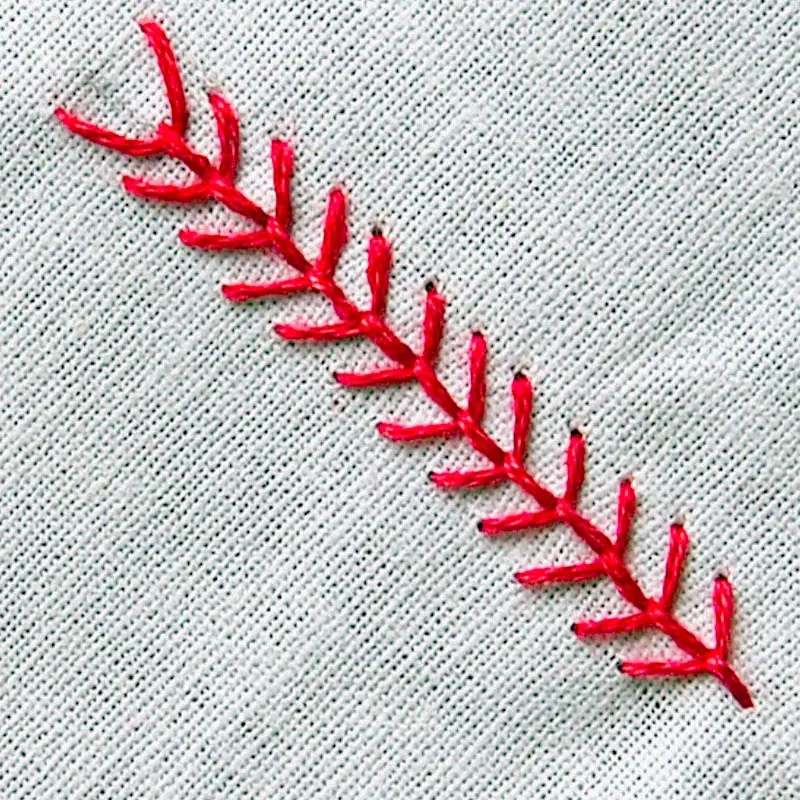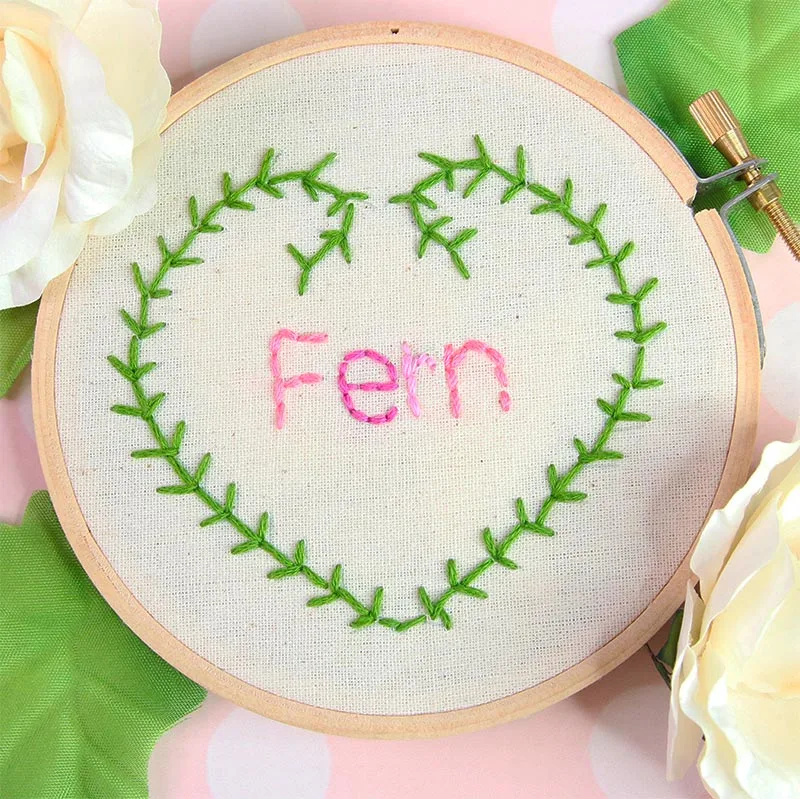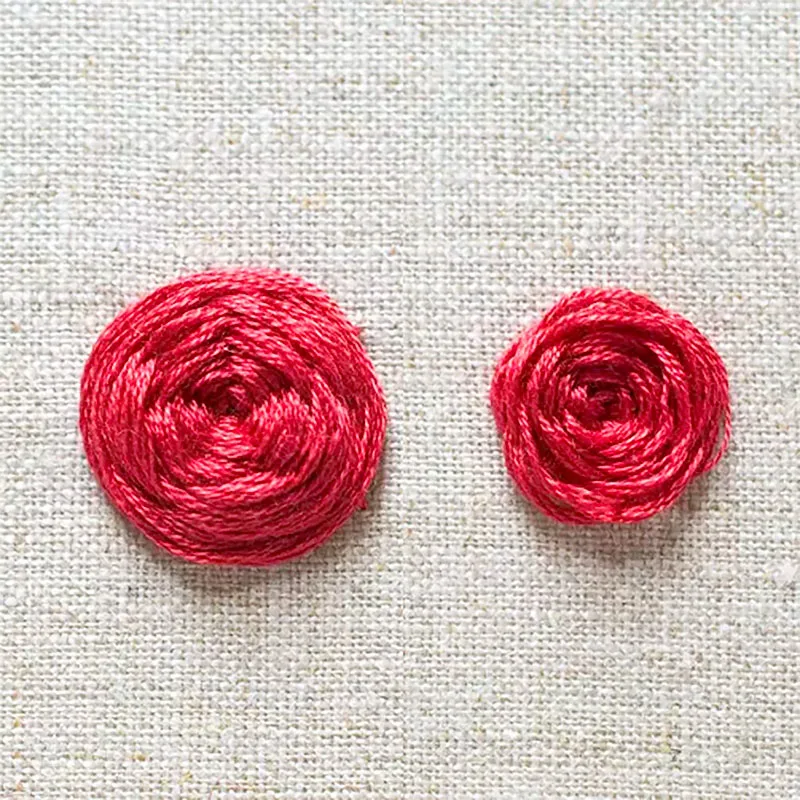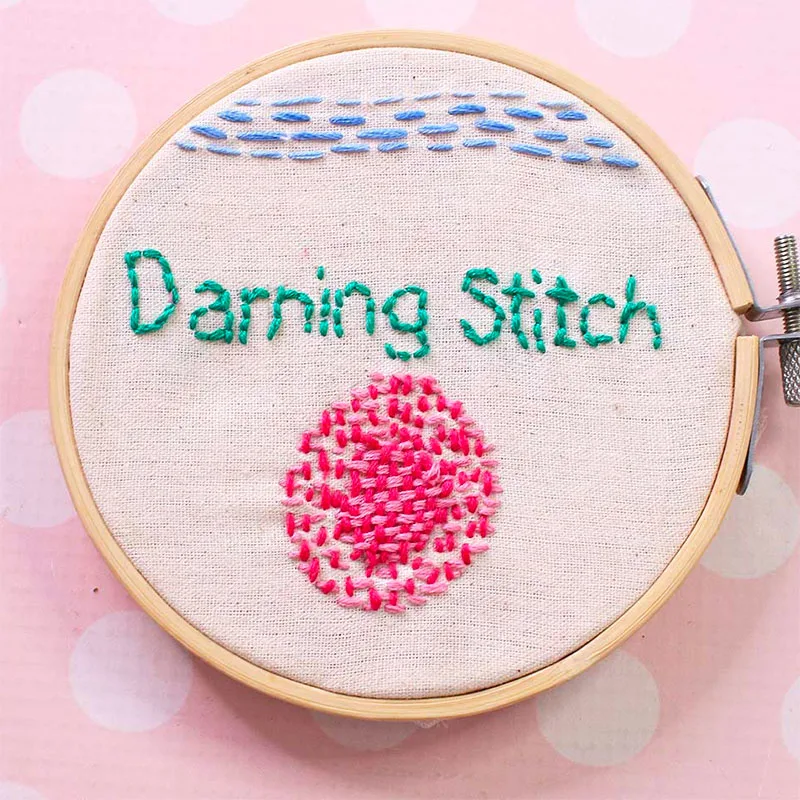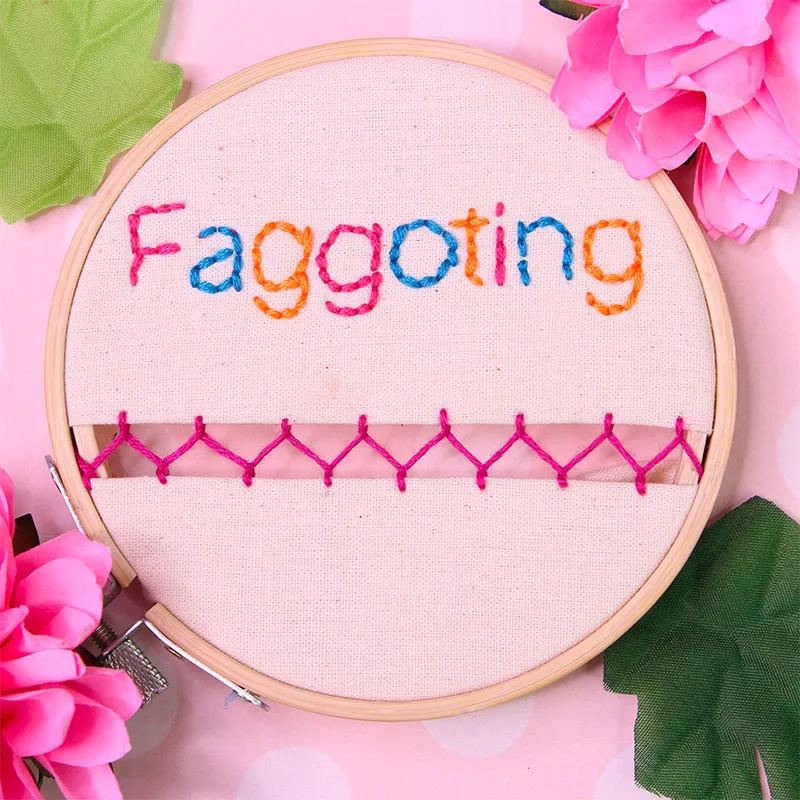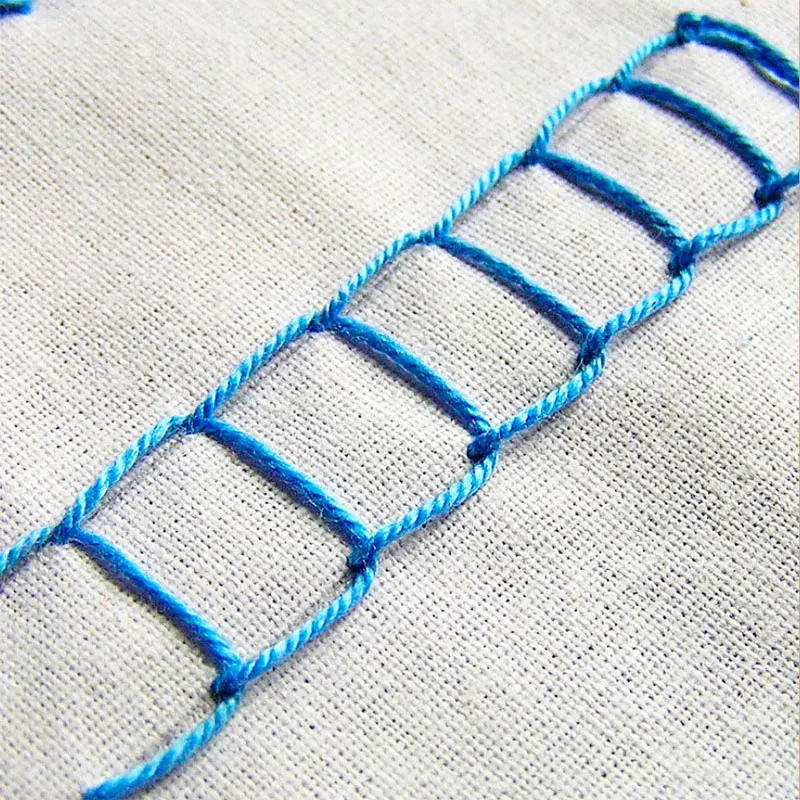Basic embroidery stitches are the building blocks of any embroidery project. Starting off your embroidery journey by practicing different stitches will give you the foundation you need in future embroidery projects.
Wondering how to do different types of embroidery stitches? Or where and what to begin with? Here, we have compiled for you a roundup of basic stitches of embroider that you will be bound to come across when venturing into embroidery. Even if you have a sewing machine, there may be times when a pattern calls for some hand embroidery. This list may then come in handy for you.

If you are a complete beginner and you need more information on the basics of sewing, for instance, starting and ending threads, choice of materials, etc. this how to hand sew for beginners and this embroidery for beginners will both be super helpful for you.
They cover the basics such as:
- Essential tools & equipment;
- How to start and end sewing by threading and tying the thread;
- Some basic hand stitches you’ll need to know;
- The most common types of fabric and;
- Basic sewing accessories you should have.
A sewing machine is definitely useful in sewing the completed embroidery project into something wonderful. This guide on choosing the right sewing machine for you is worth a read if you have yet to own your own sewing machine and don’t know where to start.
FAQs
1. How many types of embroidery stitches do I need to learn?
Considering there are nearly 300 different hand embroidery stitches and their variations, there is no set minimum requirement for getting started. Depending on the project, some embroidery designs may require you to learn a new stitch. Even the most basic embroidery projects might require the use of five different types of stitches.
Embroidery, like so many other things in life, is best viewed as a process of gradual knowledge acquisition. It’s never going to end! Begin by learning the basic stitches on this list and work your way up.
2. What are basic embroidery stitches?
The basic embroidery stitches are stitches that are the head of a stitch family. They define the characteristics of a stitch family. A stitch family is a collection of stitches that, despite initially appearing to be very diverse, all share the same characteristics.
Running stitch, cross stitch, stem stitch, backstitch, satin stitch, chain stitch, and blanket stitch are some of the basic hand embroidery stitches.
3. What are the easiest and most popular hand embroidery stitches?
The easiest embroidery stitch is the running stitch. It’s simply a series of straight stitches done in a line and can be used for hand embroidery or hand sewing. The second easiest stitch is the backstitch.
The most popular hand embroidery stitch, on the other hand, is the satin stitch. This is because it can be used to fill areas with color and is frequently used in both machine and hand embroidery.
4. What are the supplies needed for embroidery?
It doesn’t take a lot of supplies to start an embroidery project. What you need are mainly:
1. Embroidery needles
Sizes 1-10 are used for most patterns.
2. Embroidery floss (embroidery thread)
3. Embroidery (small) scissors
Small scissors are most suitable for delicate artwork like embroidery.
4. Fabric
Lower thread count fabrics are ideal for embroidery projects because they allow the needle to easily pass through the fabric. Cotton, linen, muslin, flour sack, and aida are examples of fabrics with a lower thread count.
5. Embroidery hoop
This hoop keeps your fabric taut so you can operate on it easily.
What’s Next:
- Begin your embroidery journey by practicing the following basic stitches. When you are ready you can adventure into these 50+ beautiful patterns and 40+ embroidery flowers.
- Share your completed DIY tote bag on Facebook and/or Instagram. Remember to tag us @craftpassion so that we can see them.
- Not doing it now? Then, save this post to Pinterest for the future.
- Browse more free sewing patterns to make, especially sewing bags and purses, where you can corporate some embroidery design to the plain fabric.
33 Useful Embroidery Stitches To Master
Here is a roundup of primary embroidery stitches that every beginner can use as a guide. The more essential stitches are at the top of the list, with more uncommon basic stitches or variations at the bottom.
Straight Stitch
The straight stitch is a fundamental straight line stitch that is used as a building block for various other stitches, such as the running stitch and back stitch. This tutorial has a written step-by-step guide in addition to a video tutorial.
Running Stitch
The running stitch is one of the simplest and most fundamental embroidery stitches.
Stem Stitch
The stem stitch embroidery makes a beautiful line stitch. It makes a rope-like line that varies in thickness depending on the thread you use.
Backstitch
A back stitch is a simple hand stitch that involves sewing the thread back and forth. The stitch appears to be made up of small touching stitches at the top, while the back overlaps.
Split Stitch
Split stitch is another simple embroidery stitch. It can be used for outlining as well as embroidering closely-packed lines of it for fill-stitching.
Seed Stitch
The seed stitch is essentially random small stitches that look like seeds.
Chain Stitch
The embroidery chain stitch is a great way of sewing embroidery outline stitches and lettering. It is simple and easy, definitely an essential stitch for beginners to pick up.
Detached Single Chain Stitch
The detached chain stitch is sometimes referred to as the single chain stitch. It looks like a teardrop or flower petal shape that can be used to build into other motifs.
Lazy Daisy Chain Stitch
This lazy daisy chain stitch is also known as a detached chain stitch. It is used for filling in decorated borders or creating tiny flowers. This tutorial guides you on this stitch and it also introduces you to variations of this stitch.
Blanket Stitch
The blanket stitch can be used as a surface stitch as well as an edge stitch for appliqué projects. It is commonly used to finish the raw edges of blankets and other fabrics, as well as to tack down folded hems.
Buttonhole Stitch
Buttonhole stitch embroidery is similar to blanket stitch embroidery. It is used for edging or for creating lovely flower wheels.
Feather Stitch
The feather stitch is a delicate form of chain stitch commonly used in plant embroidery. It's a great stitch to create the shape of branches, twigs, vines and water plants.
Fly Stitch
The fly stitch is a basic embroidery stitch that is incredibly versatile. Sew them vertically and horizontally to produce decorative borders, or scatter them to create textured tree trunks or branches, detailed leaves, flocks of birds, and more.
Fern Stitch
Fern stitches are beautiful delicate stitches for, you guessed it, fern leaves! They also make lovely borders for monograms and smaller designs.
Chevron Stitch
The Chevron stitch is an easy zig-zag with a cap or small line on each peak. It makes a great decorative border.
Cross Stitch
Unlike most embroidery stitches, cross-stitch is a type of counted thread embroidery done on fabric with an even and open weave, such as Aida. Cross stitches are timeless and versatile stitches that allow you to start many projects with simple X-shaped stitches. Get the beginner cross-stitch patterns while you're there!
Herringbone Stitch
The crossed threads in a herringbone stitch form a V-shaped stitch that resembles a continuous twill weave. This stitch can be used to hem a garment, decorate a crazy quilt, fill in blank spaces with a continuous line, or create a lovely border.
French Knot
The French knot is a great stitch for making small flowers or filling the centers of larger flowers. This tutorial gives tips on how to make learning a French knot much easier.
Colonial Knots
The Colonial Knot is very similar to the French Knot. The main difference is that the Colonial knots have a raised textured appearance and stand more upright. They can be sewn individually or in groups to create floral motifs.
Bullion Knot
Although Bullion knots can be a little tricky and challenging on your first few attempts, they are amazing at creating texture and beautiful flowers.
Pistil Stitch/Elongated French Knots
The pistil stitch is an elongated French knot that is commonly used to embroider flowers. This is because this stitch is a combination of a straight stitch and a French knot that looks like the pistil of a flower.
Danish Knot
Danish knots are great ways to add a little flair and texture to your embroidery. They are tiny triangular knots that can be used to make eyes, fill up spaces, and basically anything that you may need a triangle for.
satin stitch
The satin stitch embroidery forms a smooth surface akin to that of satin, hence its name, Its commonly used as a fill stitch. This tutorial shows you two ways to embroider a satin stitch.
Fishbone Stitch
The fishbone stitch can be used as a filling stitch or as an embroidery stitch that outlines the beautiful structures of feathers, leaves, and plants.
Woven Wheel Stitch
The woven wheel stitch may look like a complicated stitch compared to the rest of the stitches on this list, but its really a beginner stitch! It's usually used as a canvas to fill with beautiful florals.
Darning Stitch
The darning stitch is incredibly useful for repairing holes and rips. However, it can also be used as a decorative stitch in embroidery sewing.
Needle Weaving
Similar to darning stitch, needle weaving is a crossover between the art of embroidery and weaving. It offers variations on how threads can be woven in creating popular embroidery patterns such as the woven rose.
Couching stitch
Couching is a technique where a surface material is attached to the surface of a textile with small stitches. The surface material can be anything ranging from dried flowers to yarn or strips of fabric.
Whipped Backstitch
It may sound complicated, but whipped backstitch embroidery is simply the combination of the plain backstitch and the technique of whipping. It's neat and helps with the outline in embroidery.
Whipped and Woven Stitches
Confused between whipped and woven stitches? Check out this tutorial that clearly explains them both.
Faggoting Stitch
Faggoting is the act of joining 2 pieces of fabric with embroidery. It is often used for skirt borders and napkins.
Open Chain Stitch
This lovely, easy stitch is also known as the Roman Chain Stitch, Square Chain Stitch, and Simple Ladder Stitch. This stitch is often used as a decorative border.
Ladder Stitch
The ladder stitch is an embroidery technique that creates a tight braid on a pair of parallel lines with crossbars that resemble a ladder. It's a technique for making a fancy decorative border.












